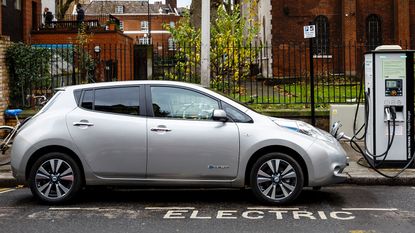Copper has hit a ten-year high, but this could just be the start of a huge bull market
The price of copper is at its highest for ten years. But supply constraints and a massive rise in demand mean it’s not going to stop there, says Dominic Frisby.


Mining analyst Mark Turner, who writes the IKN Weekly, a newsletter focused on mining in South America, recently told his subscribers in no uncertain terms to cut their exposure to Peru.
“Sell Peru”, he said. It is, as far as mining investment is concerned, “off the map”. In fact, he went as far as to recommend shorting mining companies with significant exposure to Peru.
The reason? “Resource nationalism is coming to South America.”
Subscribe to MoneyWeek
Subscribe to MoneyWeek today and get your first six magazine issues absolutely FREE

Sign up to Money Morning
Don't miss the latest investment and personal finances news, market analysis, plus money-saving tips with our free twice-daily newsletter
Don't miss the latest investment and personal finances news, market analysis, plus money-saving tips with our free twice-daily newsletter
Turner knows what he’s talking about. He’s at the coalface. He lives in Lima.
Politics could hit the supply of copper
Peru’s elections are a drawn-out process and the deciding vote comes in June. Socialist Pedro Castillo is the front runner and he is promising supertaxes of as much as 70% on mining profits in a bid to stop foreign firms “looting”, as he puts it, the country’s mining wealth.
The consequences are predictable. International companies will halt expenditure on both exploration and development. Why would they do anything else, if there is no reward for them? This means job losses for locals. What’s more, companies will reduce production, so as to leave metal in the ground until a new, more mining-friendly president comes to power. Which means diminished supply.
Peru is the world’s second largest producer, after Chile. It produced 2.2 million tonnes of copper last year, roughly 12% of annual supply. But it doesn’t look like it is going to be the world’s second largest producer for much longer.
Meanwhile, Reuters reports that Chile, which produced 5.7 million tonnes, “saw output of the red metal fall for the tenth consecutive month in March, marking a modest but continual slide in production that began shortly after the coronavirus pandemic struck the country.” Year on year production has fallen by just over 2%.
The world’s next largest producer is China, on roughly 1.6 million tonnes. Yet China is a net importer. That’s an understatement: it’s on a copper buying spree. It imported over a million tonnes more refined copper in 2020 than in 2019, and rumours of state stockpiling abound. China’s internal production can’t even meet its own internal demand, let alone what it needs for its exports’ manufacture. Between 2005 and 2020 China invested over $56bn securing overseas copper assets.
China alone accounts for over half of world copper demand, followed by Europe, then the US and Russia.
The “green revolution” will consume a lot of copper
Copper is in a runaway bull market. Demand is everywhere. Back in 2017 the World Bank was forecasting demand increases of at least 50% over the next 20 years. If the world moves towards a low-carbon energy future, then demand could rise tenfold by 2050, it claimed. Tenfold! The cause, irony of ironies, is the green energy revolution.
In terms of metal demand, this revolution is anything but green. There is an immense, underappreciated materials intensity to green energy consumption in its many forms, of which copper is a major constituent. Alternative energy systems are on average five times more copper intensive, reports the Baker Institute Center for Energy Studies in Forbes, than their conventional counterparts.
Every 1,000 battery electric vehicles (BEVs) require 83 tonnes of copper – three times the amount needed by old-school motor cars. Wind turbines require 3.6 tonnes of copper per megawatt (MW) of output and photovoltaic cells four to five tonnes per MW.
30,000 BEVs can consume as much copper as a skyscraper. For the global passenger vehicle fleet to be one-third BEV would mean 300 million BEVs, or 20 million tonnes of copper. That figure is roughly equivalent to annual global copper demand. Never mind all the plumbing, wiring, weatherproofing, machinery, electricals, electronics and multiplicity of other applications that require copper.
And one forgets there are other countries in the world that use copper. It’s not just China.
All this adds up to one thing: a copper bull market
Is the green energy revolution narrative suddenly going to go away? I doubt it very much – views are too entrenched. It might be that an extraordinarily high copper price will change the narrative and the case for fossil fuels will get stronger. It might be that an overwhelming case is made that, because of the extraordinary metal demand and the fossil fuels required to meet that demand, green energy is not quite that green after all. I can see the argument being made – it is already being made – but I can’t see it catching on. In other words, copper demand is not going away.
It all looks very bullish. This is a bull market of the secular variety, it seems.
Copper slipped below $2/lb in March last year. For the chartists out there, it formed a wonderful five-year double bottom with the lows of early 2016. It’s since made its way steadily up and today sits around $4.50/lb. It closed April at the exact price, almost to the penny, that it closed ten years earlier, at the peak of its last bull market, in April 2011.
It could be that we form a multi-year double top, and that it pulls back from this incredibly historically sensitive price point, after what has been a bonanza year.
But the momentum is up. Demand is escalating. Supply looks like it is coming under pressure. And once it breaks above its 2011 highs, what can I say? Look out above.
Dominic Frisby (“mercurially witty” – the Spectator) is the world’s only financial writer and comedian. He is MoneyWeek’s main commentator on gold, commodities, currencies and cryptocurrencies. He is the author of the books Bitcoin: the Future of Money? and Life After The State. He also co-wrote the documentary Four Horsemen, and presents the chat show, Stuff That Interests Me.
His show 2016 Let’s Talk About Tax was a huge hit at the Edinburgh Festival and Penguin Random House have since commissioned him to write a book on the subject – Daylight Robbery – the past, present and future of tax will be published later this year. His 2018 Edinburgh Festival show, Dominic Frisby's Financial Gameshow, won rave reviews. Dominic was educated at St Paul's School, Manchester University and the Webber-Douglas Academy Of Dramatic Art.
You can follow him on Twitter @dominicfrisby
-
 Coventry Building Society bids £780m for Co-operative Bank - what could it mean for customers?
Coventry Building Society bids £780m for Co-operative Bank - what could it mean for customers?Coventry Building Society has put in an offer of £780 million to buy Co-operative Bank. When will the potential deal happen and what could it mean for customers?
By Vaishali Varu Published
-
 Review: Three magnificent Beachcomber resorts in Mauritius
Review: Three magnificent Beachcomber resorts in MauritiusMoneyWeek Travel Ruth Emery explores the Indian Ocean island from Beachcomber resorts Shandrani, Trou aux Biches and Paradis
By Ruth Emery Published
-
 Halifax: House price slump continues as prices slide for the sixth consecutive month
Halifax: House price slump continues as prices slide for the sixth consecutive monthUK house prices fell again in September as buyers returned, but the slowdown was not as fast as anticipated, latest Halifax data shows. Where are house prices falling the most?
By Kalpana Fitzpatrick Published
-
 Rents hit a record high - but is the opportunity for buy-to-let investors still strong?
Rents hit a record high - but is the opportunity for buy-to-let investors still strong?UK rent prices have hit a record high with the average hitting over £1,200 a month says Rightmove. Are there still opportunities in buy-to-let?
By Marc Shoffman Published
-
 Pension savers turn to gold investments
Pension savers turn to gold investmentsInvestors are racing to buy gold to protect their pensions from a stock market correction and high inflation, experts say
By Ruth Emery Published
-
 Where to find the best returns from student accommodation
Where to find the best returns from student accommodationStudent accommodation can be a lucrative investment if you know where to look.
By Marc Shoffman Published
-
 Best investing apps
Best investing appsWe round up the best investing apps. Looking for an easy-to-use app to help you start investing, keep track of your portfolio or make trades on the go?
By Ruth Emery Last updated
-
 The world’s best bargain stocks
The world’s best bargain stocksSearching for bargain stocks with Alec Cutler of the Orbis Global Balanced Fund, who tells Andrew Van Sickle which sectors are being overlooked.
By Andrew Van Sickle Published
-
 Revealed: the cheapest cities to own a home in Britain
Revealed: the cheapest cities to own a home in BritainNew research reveals the cheapest cities to own a home, taking account of mortgage payments, utility bills and council tax
By Ruth Emery Published
-
 UK recession: How to protect your portfolio
UK recession: How to protect your portfolioAs the UK recession is confirmed, we look at ways to protect your wealth.
By Henry Sandercock Last updated